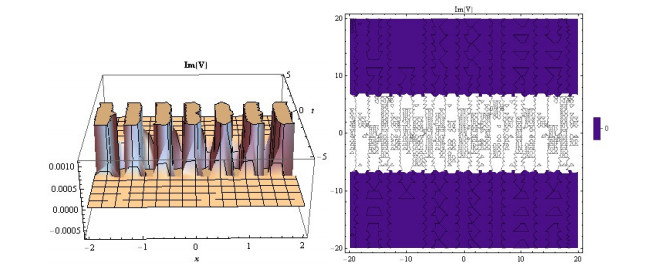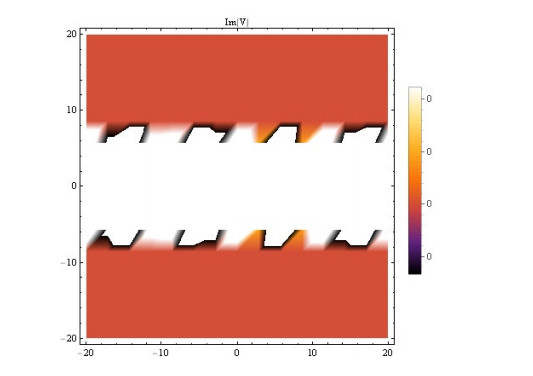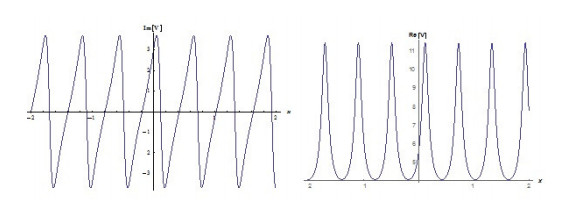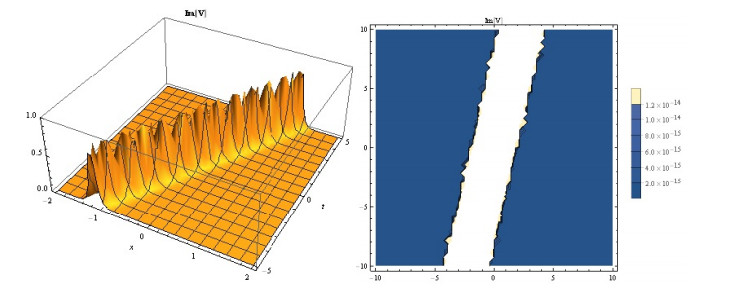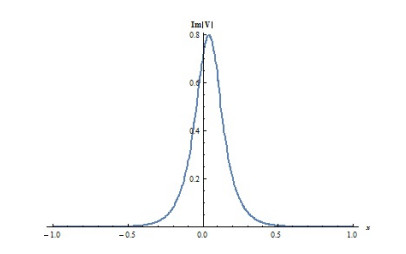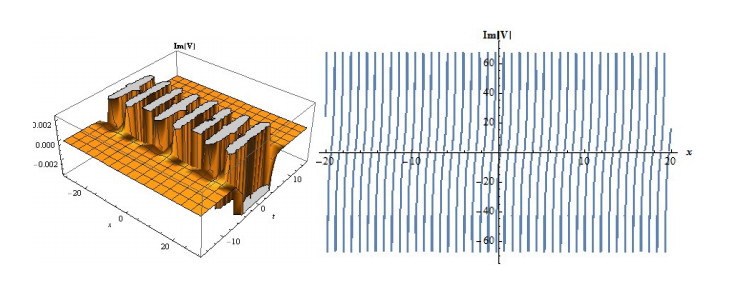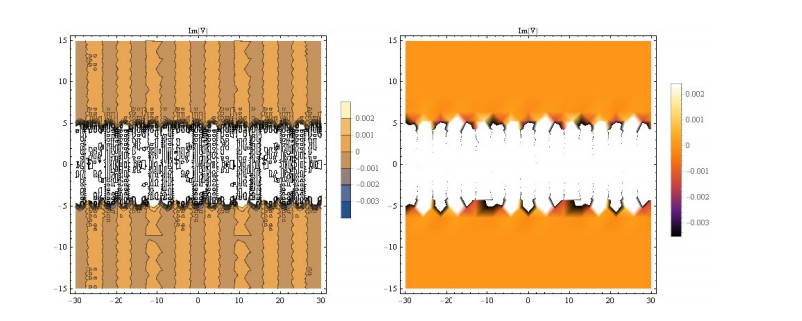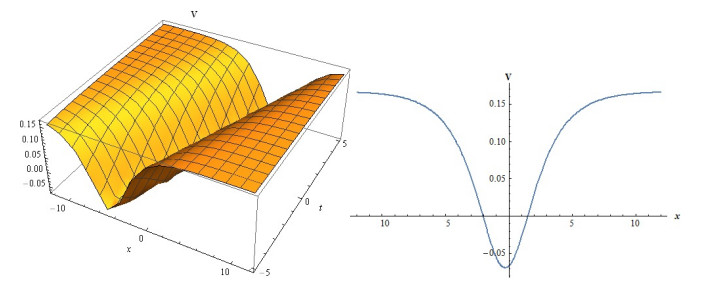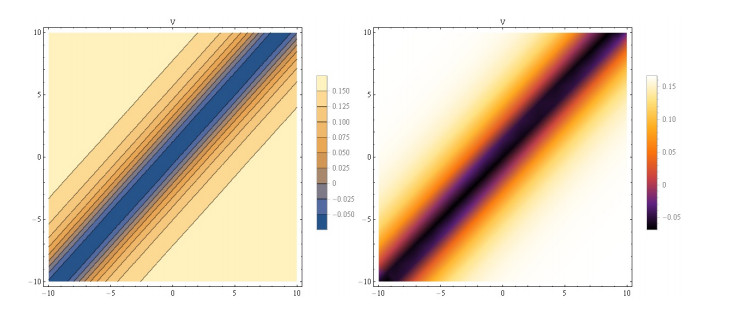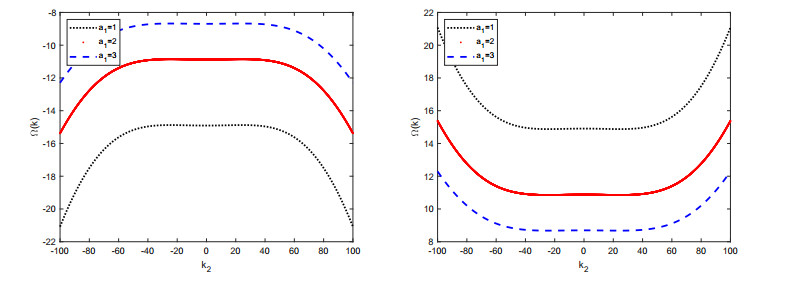This study reveals new voltage behaviors to the electrical transmission line equation in a network system by using the newly presented sine-Gordon equation function method. It is commented about these behaviors which come from different simulations of results obtained in this paper. Many illustrations are offered to validate our analytical results. Linear stability analysis is also investigated in a detailed manner.
1.
Introduction
Since molecules and molecular compounds are used to generate molecular graphs. Any graph that simulates some molecular structure can use a topological index as a mathematical formula [1]. Topological indices play a significant role in chemistry, pharmacology, etc., [2]. A molecular graph, whose vertices and edges are represented by atoms and chemical bonds, respectively, illustrates the constructional outcome of a chemical compound in graph theory form. Cheminformatics, a field shared by information science, chemistry and mathematics, has recently gained notoriety. This new topic discusses the connection between QSAR and QSPR, which is used to investigate (with a given level of accuracy) the theoretical and biological activities of specific chemical compounds [3]. For quantitative structure-activity relationships (QSARs) and quantitative structure-property relationships (QSPRs), in which the physicochemical characteristics of molecules are correlated with their chemical structure, a topological index (TI) is a real number associated with chemical structures via their hydrogen-depleted graph [4,5,6].
Chemical graph theory is a newly developed area of mathematical chemistry that combines graph theory with chemistry. The main objective of chemical graph theory is to acknowledge the structural effects of a molecular graph [7]. The molecules and molecular compounds aid in the construction of a molecular graph. Topological descriptors, which are typically graph invariants, are numerical characteristics of a graph that describe its topology [8]. The certain physiochemical characteristics of some chemical compounds, such as their boiling point, strain energy, and stability are correlated by degree-based topological indices [9].
Chemical graph theory has many applications in many areas of life, including computer science, materials science, drug design, chemistry, biological networks, and electrical networks. For this reason, academics are currently very interested in this theory [10,11]. The numerical values attached to a simple, finite graph that represent its structure are called topological indices [12]. The multiplicative Zagreb indices for mathematical features, connection indices and applications see in [13,14,15,16,17,18,19,20]. In this study, a novel method for computing the topological indices of two different chemical networks is presented. The mathematical properties of molecular structure descriptors, particularly those that depend on graph degrees, have been examined in our research. We derive neighborhood multiplicative topological indices and concise mathematical analysis for product of graphs (L) and tetrahedral diamond lattices (Ω). The fifth multiplicative Zagreb index, the general fifth-multiplicative Zagreb index, the fifth-multiplicative hyper-Zagreb index, the fifth-multiplicative product connectivity index, the fifth-multiplicative sum connectivity index, the fifth-multiplicative geometric-arithmetic index, the fifth-multiplicative harmonic index, and the fifth-multiplicative redefined Zagreb index are the topological indices that are taken into consideration. In this paper, we consider G=(V,E) to be a simple, connected and finite graph contains vertices (atoms) atoms and edges (chemical bonds linking these atoms), for notation referee to [21].
2.
The neighborhood degree-based multiplicative topological indices
In 2017, the new neighborhood degree-based multiplicative topological indices were introduced by V. R. Kulli in [22]. Let §1 and §2 denote the fifth neighborhood multiplicative M-Zagreb index defined as:
Let §3 and §5 denote the general fifth multiplicative Zagreb index that are defined as:
where α is a real number.
The fifth multiplicative hyper-Zagreb index is denoted by §4 and §6 defined as:
The fifth multiplicative product connectivity index §8 is defined as:
The fifth multiplicative sum-connectivity index of a graph G is defined as:
The fifth multiplicative geometric-arithmetic index §10 of a graph G and it is defined as:
Inspired by Kulli, Sarkar et al. [23] introduced the fifth multiplicative product connectivity index of first kind §7, the fifth multiplicative harmonic index §11 and the fifth multiplicative redefined Zagreb index §12, respectively defined as:
3.
The neighborhood degree-based multiplicative indices for tensor product L=Lp⊗Lq
For any two graphs L and M, the tensor product of the graphs L and M is interpreted as L⊗M. This product is also known as categorical product of graphs defined in [24,25]. The vertex set of L⊗M is denoted by V (L)×V (M). For any integers p and q, the tensor product Lp and Lq is described by Lp⊗Lq. This graph contains a.b number of vertices with vertex set
and edge between (t1, t2) and (t3, t4)exists if and only if:
The graph Lp⊗Lq is known as a L with vertex cardinality pq. The metric dimension of the categorial product of graphs is determined in [26] and edge irregular reflexive labeling of categorical product of two paths is determined in [27]. This shows the importance of this product in different areas. Ahmad [28] determined the upper bounds of irregularity measures of categorical product of two connected graphs. The edge partition of graph Lp⊗Lq based on the degree of end vertices is given in Table 1. This edge partition is also given in [29]. For more understanding we depicted L9⊗L10 in Figure 1.
Theorem 3.1. Let G be a tensor product of two paths. Then the fifth neighborhood multiplicative M-Zagreb indices for G are:
Proof. From the definitions of §1(G), §2(G) and Table 1, we have
Similarly,
The graphical representation of the Theorem 3.1 is given in Figure 2(a), (b).
Theorem 3.2. Let G be a tensor product of two paths. Then the general fifth multiplicative Zagreb indices of G are:
Proof. From the definitions of §3(G) and Table 1, we get
From the definitions of §5(G) and Table 1, we obtain
Theorem 3.3. Let G be a tensor product of two paths. Then the fifth multiplicative hyper-Zagreb indices for G are:
Proof. From the definitions of §4(G), §6(G) and Table 1, we obtain
The graphical representations of Theorems 3.2 and 3.3 are shown in Figure 2(c)–(f) with p and q, respectively.
Theorem 3.4. The fifth multiplicative product connectivity index §8 for tensor product of two path G is:
Proof. From the formulation of §8(G) and Table 1, it is easy to calculate that
The graphical representation of fifth multiplicative product connectivity index §8 is shown in Figure 2(g) with p and q.
Theorem 3.5. Let G be a tensor product of two paths. Then the fifth multiplicative sum-connectivity index of a graph G is:
Proof. From the formulation of §9(G) and Table 1, we get
Theorem 3.6. Let G be a tensor product of two paths. Then the fifth multiplicative geometric-arithmetic index §10 of a graph G is:
Proof. By the definition of §10(G) and using the values of Table 1, we have
The graphical representations of fifth multiplicative sum-connectivity index §9 and fifth multiplicative geometric-arithmetic index §10 is shown in Figure 3(a), (b), respectively.
Theorem 3.7. Let G be a tensor product of two paths. Then the fifth multiplicative product connectivity index of first kind is
the fifth multiplicative harmonic index is
the fifth multiplicative redefined Zagreb index is
Proof. By using Table 1, in the formulation of §7(G) §11(G) and §12(G) we get
The graphical representations of fifth multiplicative product connectivity index of first kind, the fifth multiplicative harmonic index and the fifth multiplicative redefined Zagreb index are shown in Figure 3(c)–(e), respectively.
4.
The neighborhood degree based multiplicative topological indices of tetrahedral diamond lattice Ω
A tetrahedral diamond lattice Ω is made up of t layers, each of which extends to lt. The initial layer only has one vertex, while the subsequent layer is isomorphic to S4 because it contains four vertices. Each layer l for t ≥3 has ∑l−2k=1k hexagons with 3 pendent vertices. We may set up each additional layer's vertices in accordance with the depth initial marking. To be more specific, we may use layer l to represent labels from ∑l−2k=1k2+1 to ∑l−2k=1k2. The vertex set of a Ω of size t contains vertices that are a and b while the edge set has edges that are 23(t2−t). Ω have no odd cycles, making them bipartite graphs. The graph of tetrahedral diamond lattice Ω is shown in Figure 4 and the edge partition based on the degree of end vertices is given in Table 2.
Theorem 4.1. Let Ω tetrahedral diamond lattice then the fifth neighborhood multiplicative M-Zagreb indices for Ω are:
Proof. Using the values of Table 2 in Eq (2.1), we get
The graphical representations of §1(Ω) and §2(Ω) with t is shown in Figure 5.
Theorem 4.2. Let Ω tetrahedral diamond lattice then the general fifth multiplicative Zagreb indices of Ω are:
Proof. Using the values of Table 2 in Eq (2.2), we get
Theorem 4.3. Let Ω tetrahedral diamond lattice then the fifth multiplicative hyper-Zagreb indices Ω are:
Proof. Using the values of Table 2 in Eq (2.3), we get
The graphical representations of §3(Ω)–§6(Ω), with t is shown in Figure 5.
Theorem 4.4. Let Ω tetrahedral diamond lattice then the fifth multiplicative product connectivity index Ω are:
Proof. Using the values of Table 2 in Eq (2.4), we get
The graphical representation of the fifth multiplicative product connectivity index §8(Ω) with t is shown in Figure 5.
Theorem 4.5. Let Ω tetrahedral diamond lattice then the fifth multiplicative sum-connectivity index Ω is:
Proof. Using the values of Table 2 in Eq (2.5), we get
Theorem 4.6. Let Ω tetrahedral diamond lattice then the fifth multiplicative geometric-arithmetic index Ω is
Proof. Using the values of Table 2 in Eq (2.6), we get
Theorem 4.7. Let Ω tetrahedral diamond lattice. Then the fifth multiplicative product connectivity index of first kind is
the fifth multiplicative harmonic index is
the fifth multiplicative redefined Zagreb index is
Proof. Using the values of Table 2 in Eq (2.7), we get
The graphical representations of the fifth multiplicative product connectivity index of first kind §7(Ω), the fifth multiplicative sum-connectivity index §9(Ω), the fifth multiplicative geometric-arithmetic index §10(Ω), fifth multiplicative harmonic index §11(Ω) and fifth multiplicative redefined Zagreb index §12(Ω) are shown in Figure 6.
5.
Conclusions
This study contains a novel method for computing the topological indices of different chemical networks and namely the networks are product of graphs (L) and tetrahedral diamond lattices (Ω). The mathematical topological properties of molecular structure descriptors, specifically those that depend on graph degrees, are examined in this research work. We derived neighborhood multiplicative topological indices and concise mathematical analysis for product of graphs (L) and tetrahedral diamond lattices (Ω). A few topological descriptors are studied namely, the fifth multiplicative Zagreb index, the general fifth-multiplicative Zagreb index, the fifth-multiplicative hyper-Zagreb index, the fifth-multiplicative product connectivity index, the fifth-multiplicative sum connectivity index, the fifth-multiplicative geometric-arithmetic index, the fifth-multiplicative harmonic index, and the fifth-multiplicative redefined Zagreb index are the topological indices that are taken into consideration. Moreover, a comparative study is also included in this work.
Acknowledgments
The author is grateful to the Deanship of Scientific Research of Jazan University for supporting financially this work under Waed grant No. (W44-91).
Conflict of interest
I declare that there is no conflict of interest of this article.









 DownLoad:
DownLoad:








